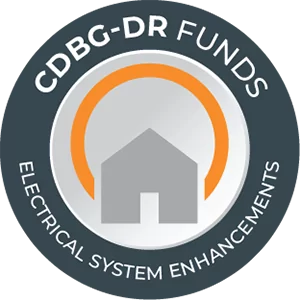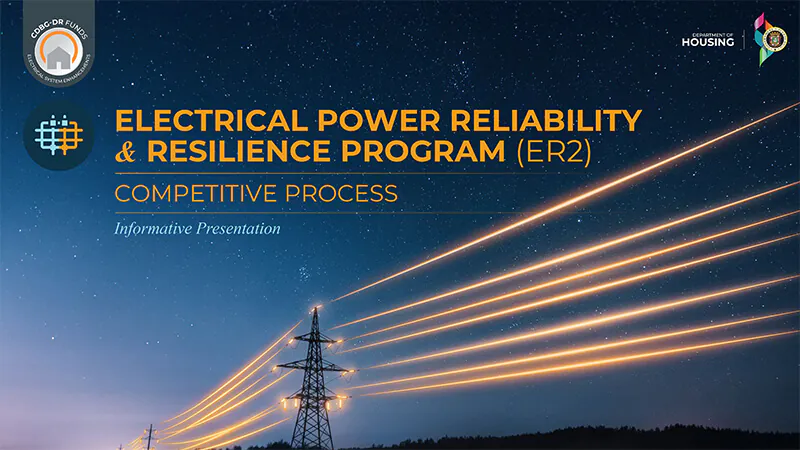
Allocation: $1,300,000,000
The program’s objective is to enhance electric system reliability, affordability, and resiliency through the development and interconnection of projects that qualify as electric system enhancements or improvements.
The application period closed on January 31st, 2024.
ELECTRICAL POWER RELIABILITY AND RESILIENCE PROGRAM
Hurricanes Irma and María struck Puerto Rico in September of 2017, and the impact of the hurricanes on the power system was devastating and led to the longest sustained blackout in modern United States (U.S.) history. Energy remains the most critical factor for the Island’s long-term recovery and future.
The CDBG-DR Energy Electrical Power Reliability and Resilience (ER2) Program’s objective is to enhance electric system reliability, affordability, and resiliency through the development and interconnection of projects that qualify as electric system enhancements or improvements. Efforts are focused on creating decentralized sources of power generation, distribution, and storage to minimize blackouts, furthering the goals defined by the Puerto Rico Energy Public Act, No. 17-2019, which sets the Island on a path to forty percent (40%) and one hundred percent (100%) renewable energy by 2025 and 2050, respectively.
GUIDELINES
PROJECT SELECTION
ER2 Program projects selected by the Puerto Rico Department of Housing (PRDOH) will be categorized as one of the following project types:

Strategic projects are projects of significant public benefit to Puerto Rico identified and selected directly by PRDOH in collaboration with critical federal, state, and local government stakeholders. These projects may be owned only by eligible public entities who become Subrecipients of PRDOH for the purpose of carrying out the selected project. Strategic projects include projects for which PRDOH has set-aside program funds as described in the Action Plan, such as the Department of Economic Development and Commerce’s (DEDC) Energy Support Program.

Competitive Application Projects are projects proposed by Applicants and submitted to PRDOH through an open competitive application process for evaluation and selection. PRDOH anticipates that competitive application projects may be developed and owned by both eligible public and private entities. Projects owned by public entities may receive up to 100% of the project’s total up-front capital costs. For projects owned by private entities, those entities will need to demonstrate financial leverage, and the Program will provide up to 60% of the project’s total up-front capital costs. The remaining 40% of project funds must come from non-CDBG funding sources.
PRDOH and its designated representatives will evaluate and select each electrical improvement project, regardless of whether it is strategically or competitively selected, based on established Threshold and Prioritization evaluation criteria.
The CDBG-DR Energy Program Guidelines for the ER2 Program state projects funded by the program must do the following:
1
Meet a HUD National Objective, see the National Objective section
2
Be an “electrical power system improvements” CDBG-DR eligible activity
3
Address an eligible unmet need after accounting for all duplication of benefits
4
Be feasible and sustainable, with all other funding sources firmly committed, if applicable.
To be eligible to receive funds under the ER2 Program, applicants must be one (1) of the following types of entities:
- Government of Puerto Rico’s Agencies, Authorities, Trusts or Boards (undertaking projects to support electrical power system improvements);
- Public-private partnerships as defined by Act 29-2009, as amended, known as “Public-Private Partnership Act”;
- Units of General Local Government (Municipalities);
- For-Profit Businesses;
- Public Hospitals or Health System Entities;
- Non-Governmental Organizations (501(c)(3)) or Not-for-Profit Entities that meet the capacity and experience requirements.











